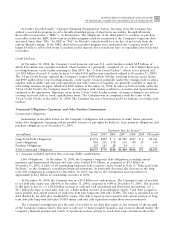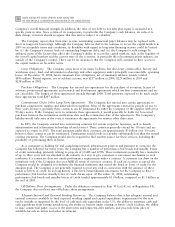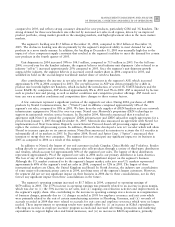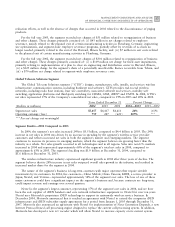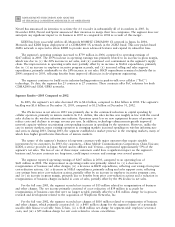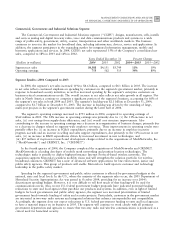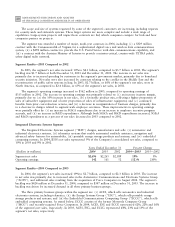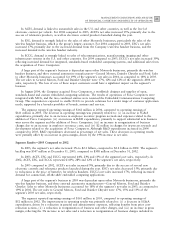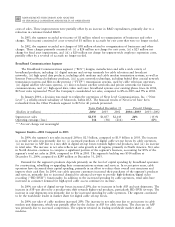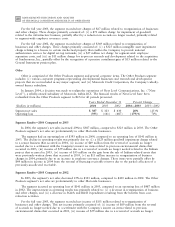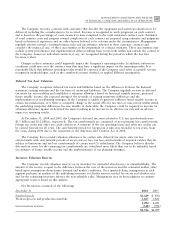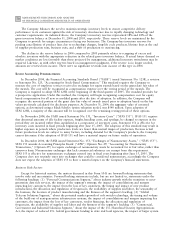Motorola 2004 Annual Report Download - page 69
Download and view the complete annual report
Please find page 69 of the 2004 Motorola annual report below. You can navigate through the pages in the report by either clicking on the pages listed below, or by using the keyword search tool below to find specific information within the annual report.
61
MANAGEMENT'S DISCUSSION AND ANALYSIS
OF FINANCIAL CONDITION AND RESULTS OF OPERATIONS
In ACES, demand is linked to automobile sales in the U.S. and other countries, as well as the level of
electronic content per vehicle. For 2004 compared to 2003, ACES's net sales increased 15%, primarily due to the
success of telematics products, as well as electronic control products launched during the year.
In ESG, demand is strongly linked to the sales of other Motorola businesses, particularly the sales of the
wireless handset business, which is the group's largest customer. For 2004 compared to 2003, ESG's net sales
increased 17%, primarily due to the increased demand from the Company's wireless handset business, and the
increased demand in the wireless handset industry.
In ECCG, demand is strongly linked to sales of telecommunications, manufacturing, imaging and other
infrastructure systems in the U.S. and other countries. For 2004 compared to 2003, ECCG's net sales increased 39%,
reÖecting increased demand for integrated, standards-based embedded computing systems, and additional sales from
the acquisition of Force Computers.
A large part of the segment's business is dependent upon other Motorola businesses, primarily the wireless
handset business, and three external automotive manufacturersÌGeneral Motors, Daimler Chrysler and Ford. Sales
to other Motorola businesses accounted for 19% of the segment's net sales in 2004, as compared to 18% in 2003.
The net sales to General Motors, Ford and Daimler Chrysler were 17%, 12% and 12% of the segment's 2004 net
sales, respectively. The loss of one of these major customers could have a signiÑcant impact on the segment's
business.
In August 2004, the Company acquired Force Computers, a worldwide designer and supplier of open,
standards-based and custom embedded computing solutions. The results of operations of Force Computers were
integrated with MCG, and the two combined entities were renamed the Embedded Communications Computing
Group. This acquisition is expected to enable ECCG to provide solutions for a wider range of customer application
needs, supported by a broader portfolio of boards, systems and services.
The segment reported operating earnings of $142 million in 2004, compared to operating earnings of
$161 million in 2003. The decrease in operating earnings was primarily related to: (i) an increase in SG&A
expenditures, primarily due to an increase in employee incentive program accruals and expenses related to the
addition of Force Computers. (ii) an increase in R&D expenditures, primarily to support substantial new business
wins across the segment and the addition of Force Computers, (iii) an increase in reorganization of business
charges due to an increase in employee severance costs, and (iv) $2 million in charges for in-process research and
development related to the acquisition of Force Computers. Although R&D expenditures increased in 2004
compared to 2003, R&D expenditures decreased as percentage of net sales. These decreases in operating results
were partially oÅset by an increase in gross margin, driven by the 19% increase in net sales.
Segment ResultsÌ2003 Compared to 2002
In 2003, the segment's net sales increased 3% to $2.3 billion, compared to $2.2 billion in 2002. The segment's
backlog was $347 million at December 31, 2003, compared to $308 million at December 31, 2002.
In 2003, ACES, ESG and ECCG represented 64%, 23% and 13% of the segment's net sales, respectively. In
2002, ACES, ESG, and ECCG represented 60%, 28% and 12% of the segment's net sales, respectively.
In 2003 compared to 2002, ACES's net sales increased 9%, primarily due to the success of several new
electronic controls and telematics products launched during the year. ESG's net sales decreased 15%, primarily due
to reductions in the price of batteries for wireless handsets. ECCG's net sales increased 17%, reÖecting increased
demand for commercial, oÅ-the-shelf embedded computing applications.
A large part of the segment's business in 2003 was dependent upon other Motorola businesses, primarily the
wireless handset business, and three external automotive manufacturersÌGeneral Motors, Ford and Daimler
Chrysler. Sales to other Motorola businesses accounted for 18% of the segment's net sales in 2003, as compared to
19% in 2002. The net sales to General Motors, Ford and Daimler Chrysler were 17%, 15% and 13% of the
segment's 2003 net sales, respectively.
The segment reported operating earnings of $161 million in 2003, compared to operating earnings of
$52 million in 2002. The improvement in operating results was primarily related to: (i) a decrease in SG&A
expenditures, driven by a reduction in general and administrative expenses, reÖecting beneÑts from prior cost-
reduction actions, (ii) a reduction in reorganization of business and other charges, and (iii) an increase in gross
margin, reÖecting the 3% increase in net sales and a reduction in reorganization of business charges included in


